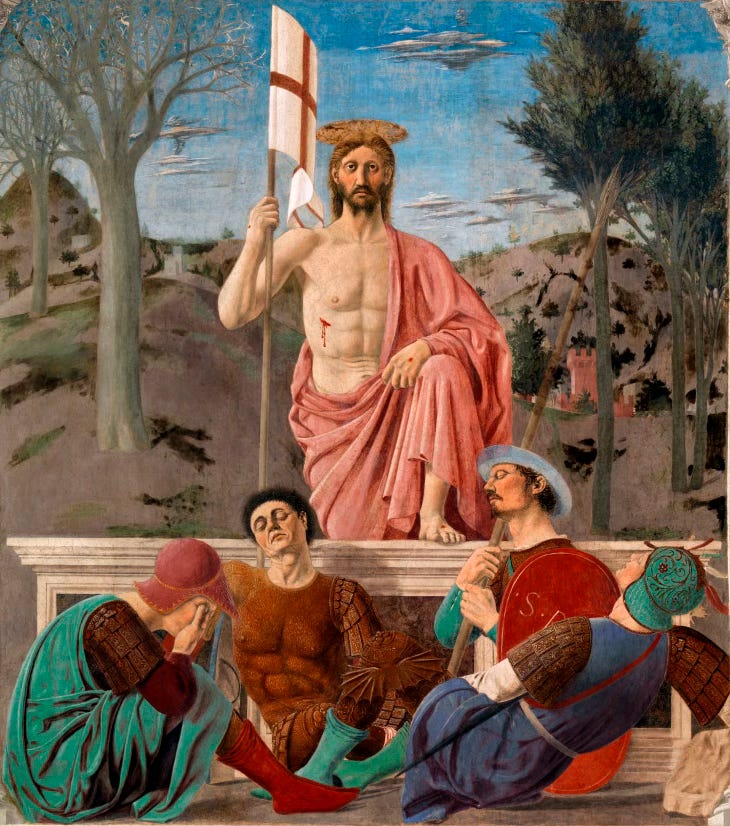Easter is my favorite holiday. Spring! Resurrection of the sleeping bulbs, the bare trees miraculously greening, flowering cherries and plums, and the promise of sweet days to come. Easter also fills my mind with the compelling story of Christ coming back to life. Whether I believe this story or not isn’t important. But all the mysteries and emotions of the story are deep and compelling.
In the Tuscan town of Sansepolcro, native son Piero della Francesca left his magnificent fresco of the resurrection. The name of the town comes from the story that someone from there brought home a relic of the sepulchre of Christ from the Holy Land. That Piero painted a muscular Christ with a gaze looking beyond this world, rising mightily from the tomb must have been subject deep in his psyche. Four Roman guards sleep through this event, the one second from left said to be a Piero self portrait.When I look at the painting, I always remember the line from T. S. Eliot’s “Gerontion”:
In the juvenescence of the year came Christ the tiger.
That the fresco survives is a wonderful story. In 1944, when the Allies were bombing the area, an English pilot was directed to strafe the town. As he flew toward it, he suddenly recalled reading in a book by Aldous Huxley that Sansepolcro was home to “the greatest painting in the world.” He made the personal decision to swerve around and avoid bombing.
So, there it is in the Civic Museum for us to see today. There are other paintings there and around town as well and the beguiling, flat town that invites wandering as well as feasting on the traditional Tuscan fare of this agricultural area. It’s a bit off the track in Tuscany but worth the short drive from Arezzo, where you can see the fresco cycle, Piero’s Legend of the True Cross. And en route, you must detour by the hilltop village of Monterchi to view the monumental Madonna del Parto, the Virgin whose blue dress is split as she is about to give birth. A subject rare and moving. This “Piero Trail” is crucial for art lovers and a bucolic idyll, too.
When I was a child, I was most puzzled and mystified to hear the Sunday School teacher read from the Gospel of Luke about what happened to Christ after he rose from the tomb. He went walking alone. Up from the dead, down the road toward Emmaus. Of all the more spectacular things he could have done! After all these decades, it is still to me the most mysterious Easter story.

What was he thinking as he walked? After the miracle, what did he want? He met two grieving and disgruntled disciples, who did not recognize him. He asked them what they were talking about and then accompanied them home for supper. This is a low-key detour in a most dramatic story. It has captivated many painters—Caravaggio (he painted two versions), Rembrandt, Pontormo, Titian, Velasquez. In the scheme of things, it’s a most humble moment. Through the breaking of bread and the communion among them, the disciples are enlightened. Then Jesus simply disappears.
There are many narrative leaps in the Easter story. All of them share the same message: Have faith. Some read the story as literal. Some read it as archetype, metaphor, or literature. Some don’t know the story at all. But spring comes, in the juvenescence of the year, and rolls us forward into the new.





The "Resurrection" really is a remarkable painting-- the stride he's taking says it all. I don't think I've ever seen a similar depiction of the Resurrection. It feels entirely original. The story of its near-destruction was as miraculous as the painting itself. Thanks so much for a wonderful post.
Thank you for bringing us along with you in your travels with your gift of art and storytelling, Frances. I’ve long enjoyed your writing, insight, and enthusiasm about poetry and art. This was another lovely experience.